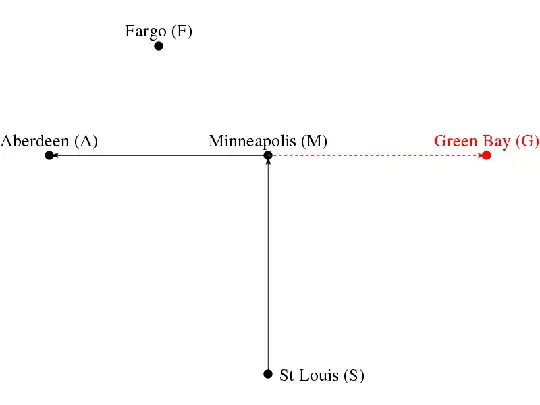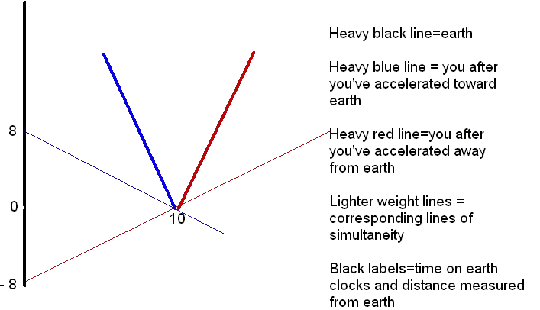I'm 10 light years from Earth and see Earth's clock/calendar reading 2000, including light travel time. In other words, I assume it's 2010 on Earth, but what I actually see is the year 2000 due to light travel time.
I now accelerate towards Earth to 0.8c in one second. What does Earth's calendar read to me now, including light travel time? The two answers I appear to be getting from my related question:
You still see Earth's calendar at the year 2000, plus maybe a few seconds.
You see Earth's calendar at 2004 (for example): it has jumped ahead several years during your acceleration.
I'm getting a variety of interesting answers to Rapid (ac/de)celeration in relativity does what to inertial clocks? but I don't think they're all consistent, which is perhaps my fault for phrasing the question ambiguously. I'm hoping this question is less ambiguous.
EDIT: This question is not a duplicate of my Rapid (ac/de)celeration in relativity does what to inertial clocks? because that other question involves acceleration, constant speed travel, deceleration, and ignores light travel time.
I believe this question is much simpler, although I agree the two are related.
The Fargo Fallacy
This section is in response to @WillO's and @hypnosifl's "driving to Fargo" analogy.
@WillO states
I am driving north toward Fargo. I say "Fargo is straight ahead, and always has been". Now I make a left and say "Fargo is to my right, and always has been".
[...]
Do you really not understand that this is shorthand for "Fargo is in the direction i now call right and always has been?" Or that my previous reckoning of Fargo as straight ahead has now become completely irrelevant? Or that if I continue to rely onthat [sic] reckoning, I'm going to get lost?
The statement "Fargo is to my right, and always has been is fundamentally inaccurate and can not be justified as shorthand.
Suppose I'm in Aberdeen and want to know where I was two hours ago (each arrow represents one hour). Using @WillO's logic, I must assume that Fargo was always to my right, and I was thus in Green Bay two hours ago.
In reality, my previous reckoning of Fargo is relevant. Here are some legitimate statements I could make:
For one hour, I was traveling from St Louis to Minneapolis, and Fargo was (pretty much) straight ahead.
For one hour, I was traveling from Minneapolis to Aberdeen, and Fargo was (pretty much) to my right.
If someone else had been traveling the Minneapolis-Aberdeen path an hour before I got there, arrived at Minneapolis at the same time I did, and was traveling at the same constant speed as I am traveling, they would have been in Green Bay when I was in St Louis.
Another way to say it: one hour after starting out, I hopped on to a ghost train that is doomed to travel forward westward at constant speed. I hopped on the train at Minneapolis and it took me an hour to get to Aberdeen. I can thus conclude the train was in Green Bay one hour ago, when I was in St Louis.
Converting any of these statements to Fargo is to my right, and always has been isn't "shorthand", it's simply false.
Fundamentally, the Fargo Fallacy confuses the history of an observer and the history of a reference frame. The "ghost train" in my example above is a reference frame: it always travels in the same direction at the same speed. However, the observer (me) wasn't on the train before it arrived at Minneapolis. In fact, it's possible that there was no one at all on the train on its journey from Green Bay to Minneapolis.
Once we understand this difference, and note that reference frames can exist without anyone in them, we can solve the problem. Ideally, we could solve this problem without using unpopulated reference frames (no ghost trains) at all. I'm checking to see if this may be possible, more details if that pans out. As @hypnosifl notes, bringing "north" into it breaks the analogy because "north" has some objective definition that doesn't depend on our choice of coordinate system. If we did have such a "north" in relativity, everything would be a lot easier, because we wouldn't have to rely on relative directions. Unforunately, the entire concept of special relativity is that all frames are relative.
The Fargo Fallacy also appears in Question/Doubt about Time Dilation Symmetry in Special Relativity: if two objects are 8 light years apart when at rest and approach each other, there is no frame of reference in which they will ever be more than 8 light years apart. However, one of the answers states:
when the light signal was sent, I was not just 4.8 light years away; I was 4.8 plus another (10.67 x .8) light years away --- a total of about 13.33 light years.
Once again, the confusion is between observers ("I") and reference frames. It was the reference frame that was 13.33 light years away, not the observer (who was never more than 8 light years away).
The 10/6 Conundrum
Consider this event: a beam of light leaves Earth in the year 2000.
Before I accelerate, this event occurs 10 light years away from me 10 years ago (since I am just now seeing this light beam). In other words, my coordinates for this event are $\{10,-10\}$ (note: I've re-oriented the x axis to face Earth, since that's the direction I will be traveling, but the conundrum occurs regardless of x axis orientation).
After I accelerate, I'm seeing the same light beam (roughly speaking), but the Earth is now only 6 light years away. I thus conclude the light beam left Earth 6 years ago (in my reference frame). Thus, my coordinates for this event are $\{6,-6\}$.
I suspect there's something wrong with my setup above, but can't figure out what it is.
Why am I suspicious? If the above is correct, the Lorentz transform for $0.8 c$ should convert between the two coordinate systems, but it doesn't.
Instead, it converts $\{10,-10\}$ to $\{30.,-30.\}$ (this is the same answer as @WillO gets), which says that, in the new, accelerated, frame, the light beam left Earth 30 light years away from my frame 30 years ago. Of course, I wasn't in this frame at the time: I only entered the frame in the year 2010 at t=0.
Oddly enough, it turns out the Lorentz transform for $-\frac{8 c}{17}$ does convert $\{10,-10\}$ to $\{6,-6\}$, but I have no idea how that velocity (a little less than $0.5 c$ and going in the opposite "wrong" direction [ie, away from Earth]) enters the picture.
Changing our definition of t=0 doesn't appear to help either. The $0.8 c$ Lorentz transform of $\{10,u-10\}$ is $\left\{30-\frac{4 u}{3},\frac{5 u}{3}-30\right\}$. There is no value for $u$ which yields $\{6,-6\}$.
Setting $u=18$ yields $\{6,0\}$ (which is interesting) giving us the correct distance, and setting $u=\frac{72}{5}$ yields $\left\{\frac{54}{5},-6\right\}$ giving us the time, but neither of these yields $\{6,-6\}$
Again, I feel I've done something wrong in setting up the above.
On the one hand, I have two reference frames, and the Lorentz transform should be able to convert between them, since it accounts for time dilation, Lorentz contraction and simultaneity.
On the other hand, well, it doesn't seem to actually do that.

